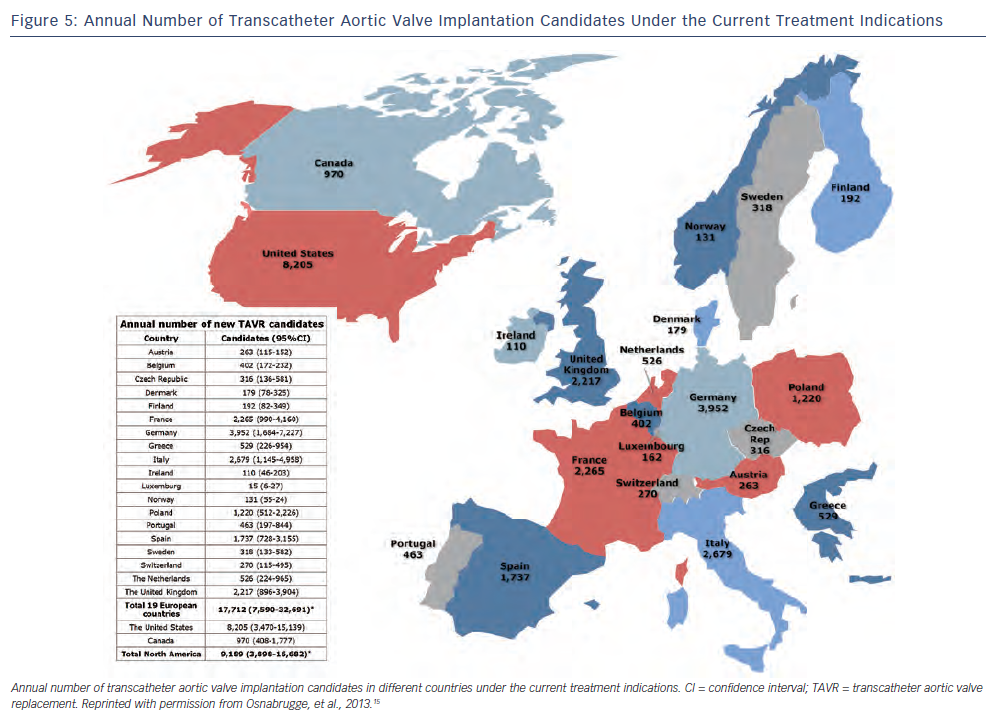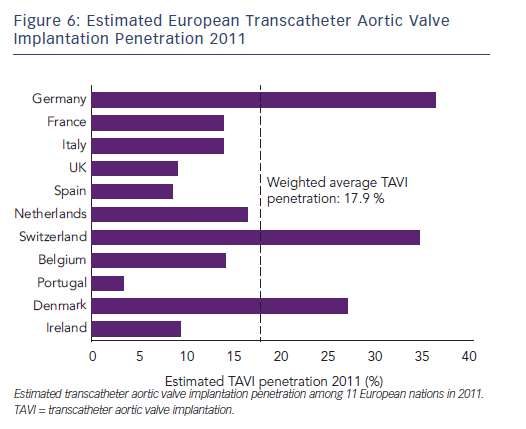Number of Potential Transcatheter Aortic Valve Implantation Candidates
Recently, Osnabrugge et al. evaluated the potential number of TAVI candidates in 19 European nations and in North America.15 These authors estimated the  prevalence of severe aortic stenosis in the elderly (75 years) to be 3.4 % (95 % confidence interval [CI], 1.1-5.7 %). To calculate the number of potential TAVI candidates in each nation, a meta-analysis was performed, which focused on published data describing the treatment pathway of high-risk aortic stenosis patients. It was estimated that 75.6 % of patients with severe aortic stenosis were symptomatic, 40.5 % were inoperable due to excessive surgical risk, and among patients that undergo surgical aortic valve replacement (SAVR), 5.2 % were at high operative risk (Society of Thoracic Surgeons risk of mortality >10 %). Finally, 40.3 % of inoperable patients and 80.0% of high-risk patients were deemed to be potential TAVI candidates.
prevalence of severe aortic stenosis in the elderly (75 years) to be 3.4 % (95 % confidence interval [CI], 1.1-5.7 %). To calculate the number of potential TAVI candidates in each nation, a meta-analysis was performed, which focused on published data describing the treatment pathway of high-risk aortic stenosis patients. It was estimated that 75.6 % of patients with severe aortic stenosis were symptomatic, 40.5 % were inoperable due to excessive surgical risk, and among patients that undergo surgical aortic valve replacement (SAVR), 5.2 % were at high operative risk (Society of Thoracic Surgeons risk of mortality >10 %). Finally, 40.3 % of inoperable patients and 80.0% of high-risk patients were deemed to be potential TAVI candidates.
Extrapolating these data, Osnabrugge et al. estimated that there are 189,836 (95 % CI, 80,281-347,372) TAVI candidates in the Europe and 102,558 (95 % CI, 43,612-187,002) in North America. Annually, there are 17,712 (95 % CI, 7,590-32,691) new TAVI candidates in Europe and 9,189 (95 % CI, 3,898-16,682) in North America (see Figure 5). Like all meta-analyses and modelling studies, this study has limitations, such as differences in the definition of aortic stenosis used among the included studies and more importantly, the difficulty associated with determining the number of inoperable or high-risk patients that are truly suitable for TAVI.16 In the future, more comprehensive prospective national and international registries detailing the actual treatment of high-risk aortic stenosis patients (medical therapy, SAVR, TAVI) will provide invaluable insights into the management of aortic stenosis patients. In the meantime, the study by Osnabrugge et al. reflects the best available evidence detailing the prevalence of severe aortic stenosis in the elderly, and provides the only estimate of the number of potential of TAVI candidates.
Estimated Transcatheter Aortic Valve Implantation Penetration
The penetration of a therapy describes actual use relative to potential use. Applying the 2011 TAVI implant data to the number of potential TAVI candidates, one  can approximate the penetration of TAVI in each nation (see Figure 6). In Germany, the estimated TAVI penetration rate was 36.2 %; that is, 36.2 % of TAVI eligible patients went on to receive TAVI in 2011. This contrasts considerably with the estimated penetration rate in Portugal (6.4 %). The weighted average TAVI penetration was calculated according to the weight (number of TAVI cases performed) or relative contribution of each individual nation to the average). Overall, the weighted average penetration rate for the 11 European nations was only 17.9 %.
can approximate the penetration of TAVI in each nation (see Figure 6). In Germany, the estimated TAVI penetration rate was 36.2 %; that is, 36.2 % of TAVI eligible patients went on to receive TAVI in 2011. This contrasts considerably with the estimated penetration rate in Portugal (6.4 %). The weighted average TAVI penetration was calculated according to the weight (number of TAVI cases performed) or relative contribution of each individual nation to the average). Overall, the weighted average penetration rate for the 11 European nations was only 17.9 %.
It is important to note that the denominator for estimating TAVI penetration is based on the number of potential TAVI candidates described by Osnabrugge et al. As such, the TAVI penetration calculation is subject to the limitations of this study. As noted by Webb et al., a more conservative estimation of the number of potential TAVI candidates would have altered the penetration calculation significantly.17 For example, a commercial analysis of the US TAVI market has suggested that TAVI penetration is already at approximately 45 %, despite the delayed and highly restrictive introduction of TAVI in that country.18
With ongoing trials in intermediate-risk patients, it is generally expected that TAVI use will continue to rise worldwide. Device iteration, documentation of long-term efficacy, and reduced costs will drive the adoption of this therapy. Furthermore, as patient selection and procedural outcomes improve, the currently underappreciated morbidity and mortality advantages of TAVI are likely to become apparent, and it is likely that TAVI utilisation will increase further.
Transcatheter Aortic Valve Implantation Funding and Reimbursement Issues
Given the prevalence of aortic stenosis in the elderly, the ageing global population, and the absence of effective preventative therapies, the economic burden of aortic stenosis is increasing. Of course, the adoption of TAVI is affected by economic conditions: more prosperous nations that spend more on healthcare tend to perform more TAVIs.12 Implant rates are also affected by reimbursement strategies - nations with TAVI-specific diagnosis-related groups that cover all of the costs of TAVI tend to perform more TAVI than nations where the cost of TAVI is reimbursed and constrained at local level.12 Importantly, these differences in reimbursement may also have the potential to impact patient outcomes; as in nations with more constrained local reimbursement, less experience with the procedure is developed.